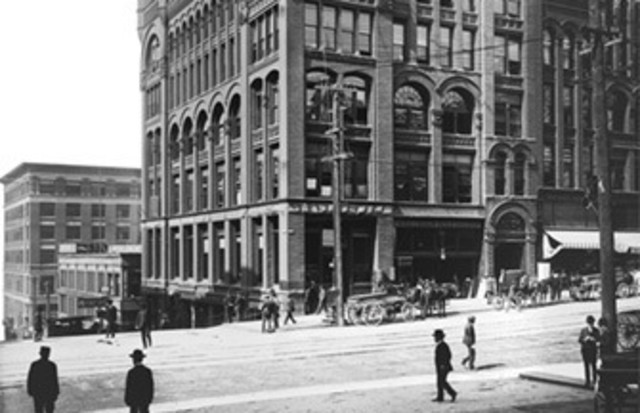Vanishing Acts

LAST JULY, Seattle’s Department of Neighborhoods released an eye-opening inventory of 200-plus downtown buildings that might require historic—landmark protection. Here’s one that got away. The G. Morris Haller Building, heaped with Victorian ornamentation in this circa 1905 photograph, yielded 50 years ago to one of Seattle’s first modern skyscrapers. Lost with the building was the memory of its namesake builder, though he was once a rising star on Seattle’s civic and commercial scene.
George Morris Haller knew danger and adventure from an early age. At 12, he fought at Gettysburg beside his father, Major Granville O. Haller, a renowned (and, today, notorious) Indian fighter who fled to the wild Washington Territory after supposedly insulting President Lincoln and acquired sprawling tracts of land here. With that leg up, Morris Haller climbed fast. He became one of Seattle’s top lawyers, sharing a practice with Judge Thomas Burke, the UW museum’s namesake. Young Haller had vast holdings in seven counties, including nearly 2,000 acres in Seattle. (By contrast, Paul Allen owns about 60 acres here today.) He organized train and utility companies and served as assistant adjutant general of the Washington National Guard. When anti-Chinese riots broke out in 1886, Haller joined Burke in calming the mob and forestalling a forced expulsion of Seattle’s Chinese immigrants.
It was a time when cities were rebuilt in a year. And fortunes rose and fell in the blink of an eye.
Then, on June 6, 1889, the Great Fire devastated Seattle. Haller and other businessmen saw the chance to replace charred wooden buildings with the sort of brick-and-stone downtown a real city ought to have. He hired Elmer H. Fisher, one of postfire Seattle’s most prolific architects, to design a five-story commercial building at the corner of Second and Cherry.
Soon after construction began, in early December 1889, Haller set out on a duck-hunting trip with Dr. Thomas T. Minor, a physician, civic leader, and public schools advocate (Minor Avenue and T. T. Minor School are named for him); and Lewis Cox, a 22-year-old apprentice in Haller’s law office who was also his wife Anna’s brother. The three embarked from Stanwood by canoe, intending to cross Skagit Bay and the treacherous Saratoga Passage to Whidbey Island. They never made it. Search parties found some of their belongings washed up on the frigid shore.
The three embarked by canoe for Whidbey Island. They never made it.
Assuming the trio had drowned, Seattleites turned out for a massive memorial service two weeks later. Local and state dignitaries heaped on accolades, praising Haller’s and Minor’s civic leadership. Anna Haller had lost a brother and, after just a year of marriage, a husband—and still the tragedies piled up. Among the relatives who came to Seattle to offer comfort was Anna’s 14-year-old brother Norman. On January 3, 1890, he went sledding, crashed into a telegraph pole, and died within the hour. That same day, Morris Haller’s badly decomposed body surfaced off Whidbey Island. The newspapers responded with extravagant expressions of sympathy and horror, but Anna was practical: She postponed Norman’s funeral so she could bury them both together the next day. Her brother Edward’s body was found in February on Camano Island; Minor’s was never recovered.
{% display:image for:article image:1 align:right height:200 %}
When Haller died, he had already invested $40,000 in his building. His parents spent $20,000 more to complete it and blazoned his name across the cornice. But over the ensuing 34 years they let the building run down. Finally they sold it to the Seattle Title Trust Company. It was demolished in 1957 to make way for the 19-story Norton Building, which stands there still.
A few years after Morris’s death, Anna Haller’s name disappeared from the newspapers and the phone directory. By 1948 only one descendant of Granville O. Haller still lived in town; now none of the Hallers listed in the directory claim any relation to him. Only Haller Lake, which Morris’s brother Theodore named for himself after purchasing land along it, perpetuates the family name in Seattle. (Theodore also erected a fountain dedicated to his father and brother in Port Townsend.)
Had a curse fallen on Morris Haller’s clan? If so, it seemed to reach even his architect Elmer Fisher. After designing much of the city that sprouted up after the fire, Fisher lost his own property in the Panic of 1893. He moved to Los Angeles and died in obscurity in 1905. Few of his many buildings stand today. But one, the magnificent stone-clad Pioneer Building, still dominates Pioneer Square, a Romanesque Revival reminder of a time when cities were rebuilt in a year and fortunes rose in the blink of an eye—and ended with the tip of a canoe.




